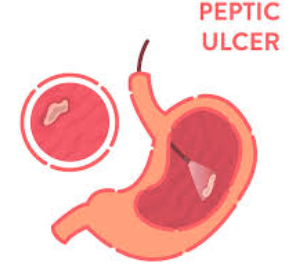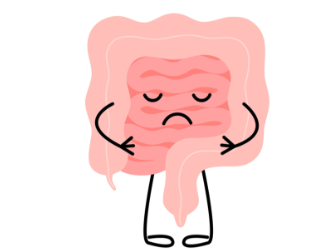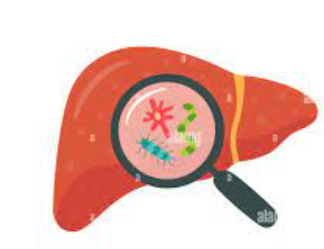Conditions
Common Digestive Conditions We Treat
1. GERD: Beyond Heartburn

What is GERD?
GERD typically refers to Gastroesophageal Reflux Disease, commonly abbreviated as GERD. It’s a chronic condition where stomach acid or, occasionally, bile flows back into the food pipe (esophagus), which can irritate the lining.
Symptoms
Heartburn: A burning sensation in the chest, usually after eating, which might be worse at night or when lying down.
Regurgitation: A sour or bitter-tasting acid backing up into your throat or mouth
Diagnosis
Upper GI endoscopy
Esophageal manometry
Esophageal pH monitoring
Treatment
Lifestyle Changes: Modify your diet, avoid triggers, and maintain a healthy weight.
Quit smoking and avoid lying down after meal
Medications: Antacids for quick relief
Acid-reducing drugs for longer-term management
Surgery: Recommended in severe cases or when other treatments are ineffective.
2. Functional Dyspepsia: Beyond Indigestion

What is Functional Dyspepsia?
Functional dyspepsia is a common gastrointestinal disorder characterized by persistent or recurring bloating or pain with no clear cause.
Symptoms
The main symptoms of functional dyspepsia include:
- Persistent or recurring pain or discomfort centered in the upper abdomen
Bloating - Early satiety (feeling full after eating only a small amount of food)
- Nausea
- Belching
Diagnosis
Diagnosing functional dyspepsia usually involves ruling out other causes. Tests required may include blood tests and sometimes endoscopy
Treatment
Treatment for functional dyspepsia may involve a combination of lifestyle changes, medications, and sometimes psychological interventions:
Lifestyle Changes:
Eating smaller, more frequent meals
Avoiding trigger foods and beverages, such as fatty foods, coffee ,alcohol and managing stress
Medications: Antacids and acid-inhibiting drugs
3. Treating Peptic Ulcers for Lasting Comfort

What is Peptic Ulcer Disease (PUD)?
Peptic ulcer disease (PUD) is a condition where open sores develop on the inner lining of the stomach and the upper part of the small intestine. The most common cause of peptic ulcers is the infection with Helicobacter pylori bacteria, and long-term use of nonsteroidal anti-inflammatory drugs (NSAIDs), such as ibuprofen and aspirin. Other factors like smoking, excessive alcohol use, and stress can also contribute to the development of ulcers.
Symptoms
The most common symptom of peptic ulcer disease is stomach pain, abdominal fullness and vomiting with decreased appetite.
Diagnosis
Diagnosis of peptic ulcer disease typically involves:
Upper gastrointestinal (GI) endoscopy with test for h.pylori
Treatment
Treatment of peptic ulcer disease depends on the cause of the ulcers.
Options include:
Antibiotics: To kill H. pylori bacteria if they are the cause.
Proton pump inhibitors (PPIs) and antacids: Drugs that reduce stomach acid to allow healing of the ulcer
Avoiding NSAIDs: If NSAIDs are the cause, stopping them or reducing their use is necessary.
Lifestyle changes such as quitting smoking, limiting alcohol, and avoiding spicy foods can also help manage symptoms and prevent the progression of the disease.
4. IBS Relief: Finding the Right Treatment

What is Irritable Bowel Syndrome (IBS)?
Irritable Bowel Syndrome (IBS) is a common disorder affecting the large intestine, leading to symptoms such as cramping, abdominal pain, bloating, gas, and changes in bowel habits (diarrhea and/or constipation). IBS is a chronic condition that needs long-term management.
Symptoms
Abdominal pain or cramping
Bloating
Gas
Diarrhea or constipation — sometimes alternating bouts of constipation and diarrhea
Diagnosis
TIBS is typically diagnosed based on a pattern of symptoms. There is no specific test for IBS. The process often involves:
Medical history: Assessing symptoms and their duration.
Exclusion of other conditions: Blood tests to rule out other problems, stool tests may be used to exclude infections or inflammation.
Imaging tests and endoscopy: These may be conducted to exclude other causes if symptoms don’t exclusively fit IBS or if alarm features like weight loss, fever, or blood in the stool are present.
Treatment
Treatment for IBS focuses on relieving symptoms so that you can live as normally as possible. Mild signs and symptoms can often be controlled by managing diet, lifestyle, and stress. More-severe symptoms might require medication and counseling.
Dietary adjustments: Individual responses vary, but common triggers include gluten, certain carbohydrates called FODMAPs, dairy, and caffeine.
Fiber supplements: Can help manage constipation.
Medications: Antispasmodic medications can relieve muscle spasms in the gut. Laxatives may be prescribed for constipation, and medications that control bowel motility can be used for diarrhea.
Psychological therapies: Stress can trigger symptoms in many people with IBS; therapies like cognitive behavioral therapy or mindfulness training may help manage symptoms
5. Constipation: Treatment

What is Constipation?
Constipation is common digestive issues that can vary in severity and duration. Each condition has distinct symptoms and treatment approaches.
Symptoms
Infrequent bowel movements (typically fewer than three times a week)
Hard, dry, or lumpy stools
Difficulty or straining during bowel movements
Feeling of incomplete evacuation
Diagnosis
Constipation is typically diagnosed based on symptoms and medical history. Tests are rarely needed but may include blood tests or a colonoscopy if there is concern about underlying conditions.
Treatment
Dietary changes: Increasing fiber intake through fruits, vegetables, and whole grains.
Hydration: Drinking plenty of water.
Exercise: Regular physical activity.
Laxatives: Over-the-counter laxatives can help but should be used under medical advice.
Stool softeners: These make stool easier to pass.
6. IBD: Finding Relief & Managing Symptoms

What is Inflammatory Bowel Disease (IBD)?
Inflammatory Bowel Disease (IBD) is a term used to describe disorders that involve chronic inflammation of the digestive tract. The two main types of IBD are:
Crohn’s Disease: This type can cause inflammation anywhere along the lining of the digestive tract, and often spreads deep into affected tissues.
Ulcerative Colitis: This type affects the lining of the large intestine (colon) and the rectum. It usually occurs in a continuous manner, starting at the rectum and spreading upwards.
Symptoms
Common symptoms of IBD include, but are not limited to:
Persistent diarrhea
Abdominal pain and cramping
Blood in the stool
Reduced appetite
Weight loss
Fatigue
Diagnosis
IBD is diagnosed using a combination of methods:
Blood tests can check for anemia or signs of infection.
Stool tests can detect blood, inflammation, and infections.
Colonoscopy allows visual inspection of the entire colon and the terminal ileum while collecting tissue biopsies.
Endoscopy can be used to view different parts of the gastrointestinal tract, depending on the symptoms.
Imaging tests like CT scans or MRI scans are used to see detailed images of the bowel and tissues outside the bowel.
Treatment
Treatment of IBD usually involves a combination of approaches:
Medication: The goal is to reduce the inflammation that triggers the symptoms. Common medications include anti-inflammatory drugs, immune system suppressors, antibiotics, antidiarrheal medications, and pain relievers.
Surgery: In severe cases, surgery may be necessary to remove damaged portions of the gastrointestinal tract.
The management of IBD often requires a multidisciplinary approach, including gastroenterologists, dietitians, and sometimes surgeons.
7. Understanding & Treating Liver Disease

What is Liver Disease?
Types of Liver Diseases:
Viral Hepatitis: Infections like hepatitis A, B, and C can cause inflammation that affects liver function.
Alcoholic Liver Disease: Caused by excessive consumption of alcohol, leading to inflammation, steatosis, or more severe forms such as cirrhosis and alcoholic hepatitis.
Obstructive jaundice, also known as obstructive cholestasis, occurs when there is a blockage in the bile ducts, preventing bile from flowing properly from the liver into the intestines.
Common causes of obstructive jaundice include: Gallstones blocking the bile duct or cancers in the bile ducts, liver, pancreas, or surrounding organs
Non-Alcoholic Fatty Liver Disease (NAFLD): Associated with metabolic syndrome, obesity, type 2 diabetes, and high cholesterol, leading to fat accumulation in the liver.
Cirrhosis: The late stage of scarring (fibrosis) of the liver caused by many forms of liver diseases and conditions.
Autoimmune Hepatitis: A rare disease where the body’s immune system attacks liver cells, causing inflammation and damage.
Gallstones: These are hardened deposits that form in the gallbladder. Gallstones can vary in size and composition, with cholesterol stones and pigment stones being the two main types. They can cause symptoms such as abdominal pain, nausea, and vomiting, and can lead to complications like blockage of the bile ducts.
CBD stones (Common Bile Duct stones): These are stones that are present in the common bile duct, which is the tube that carries bile from the liver and gallbladder to the small intestine. CBD stones can form in the gallbladder and migrate into the common bile duct, or they may form directly within the duct. They can cause symptoms similar to gallstones, and if left untreated, they can lead to complications such as jaundice or pancreatitis.
Symptoms
Symptoms of liver disease can vary, but commonly include:
Jaundice (yellowing of the skin and eyes)
Abdominal pain and swelling
Swelling in the legs and ankles
Itchy skin
Dark urine color
Pale stool color
Chronic fatigue
Nausea or vomiting
Loss of appetite
Tendency to bruise easily
Symptoms of obstructive jaundice may include yellowing of the skin and eyes, dark urine, pale stools, itching, abdominal pain, nausea, and vomiting
Diagnosis
Liver disease is diagnosed using a combination of history, physical examinations, blood tests, imaging, and sometimes biopsy:
Blood tests: Liver function tests assess levels of liver enzymes, bilirubin, and proteins which indicate how well the liver is functioning.
Imaging tests: Ultrasound, CT scans, and MRIs can visualize the liver and assess structural and vascular changes.
Liver biopsy: Involves taking a small sample of liver tissue to examine under a microscope.
FibroScan: A special ultrasound machine that measures fibrosis (scarring) and steatosis (fat accumulation) in the liver.
Treatment
Treatment depends on the type and stage of liver disease:
Lifestyle changes: This includes alcohol cessation, weight loss, and a healthy diet, particularly in alcoholic liver disease and NAFLD.
Medications: To treat specific conditions like autoimmune hepatitis, viral hepatitis and cirrhosis.
Surgery or Transplantation: In cases of severe cirrhosis or liver cancer, a liver transplant might be necessary.
Managing complications: Such as using diuretics for fluid buildup and antibiotics for infections. Preventative measures are crucial, especially for viral hepatitis and alcoholic liver disease. Vaccinations are available for hepatitis A and B, and avoiding alcohol or moderating intake can prevent many liver ailments.
Regular medical check-ups and blood tests can help detect liver disease early, improving the outcome.
Treatment of obstructive jaundice depends on the underlying cause but may involve procedures to remove the blockage or stone (e.g., ERCP with stent placement), surgery for gall bladder stone or to bypass or remove the obstruction, or other interventions such as chemotherapy or radiation therapy for cancers. Prompt diagnosis and treatment are essential to prevent complications and improve outcomes.se.
8. Understanding & Treating Pancreatitis Disease

What is Pancreatitis Disease?
Pancreatitis is inflammation of the pancreas, a gland located behind the stomach. The pancreas plays a crucial role in digestion and hormone regulation. When the pancreas becomes inflamed, it can lead to severe abdominal pain and other complications.
Symptoms
Abdominal pain: Pain in the upper abdomen that may become more intense and radiate to the back.
Nausea and vomiting
Jaundice
Diagnosis
Diagnosis of pancreatitis involves a combination of medical history, physical examination, and diagnostic tests:
Blood tests: To measure levels of pancreatic enzymes (amylase and lipase), as elevated levels indicate pancreatic inflammation.
Imaging tests: Such as ultrasound, CT scan, or MRI to visualize the pancreas and detect any abnormalities like inflammation, gallstones, or fluid collections.
Treatment
Treatment of pancreatitis depends on the severity and underlying cause:
Hospitalization: Severe cases may require hospitalization for pain management, hydration, and monitoring for complications.
Pain management: Medications such as analgesics may be prescribed to relieve pain.
IV fluids: To prevent dehydration and maintain electrolyte balance.
Treatment of underlying causes:
If pancreatitis is caused by gallstones, surgery to remove the gallbladder may be necessary. Lifestyle changes such as avoiding alcohol or dietary adjustments may be recommended for other causes.
In severe cases or complications like infected pancreatic necrosis or pseudocysts, endoscopic drainage or surgery may be required to drain fluid collections or remove damaged tissue.
9. Cancers of the gastrointestinal tract can occur in various organs and they are:
Esophageal Cancer:
- Symptoms: Difficulty swallowing (dysphagia), unintentional weight loss, chest pain or discomfort, persistent cough, hoarseness.
- Diagnosis: Endoscopy with biopsy, imaging tests like CT scan or PET scan.
- Treatment: Surgery, chemotherapy, radiation therapy, targeted therapy.
Stomach Cancer (Gastric Cancer) :
- Symptoms: Abdominal pain or discomfort, unintentional weight loss, nausea and vomiting, difficulty swallowing, bloating after meals.
- Diagnosis: Endoscopy with biopsy, imaging tests like CT scan or MRI.
- Treatment: Surgery, chemotherapy, radiation therapy, targeted therapy.
Small Intestine Cancer :
- Symptoms: Abdominal pain or cramps, unexplained weight loss, blood in the stool, fatigue, nausea and vomiting.
- Diagnosis: Imaging tests like CT scan or MRI, capsule endoscopy, biopsy.
- Treatment: Surgery, chemotherapy, radiation therapy.
Colon Cancer :
- Symptoms: Changes in bowel habits (diarrhea or constipation), blood in the stool, abdominal pain or discomfort, unexplained weight loss.
- Diagnosis: Colonoscopy with biopsy, imaging tests like CT scan or MRI, fecal occult blood test.
- Treatment: Surgery, chemotherapy, radiation therapy, targeted therapy.
Pancreatic Cancer :
- Symptoms: Abdominal pain or discomfort, unexplained weight loss, jaundice (yellowing of skin and eyes), digestive problems, back pain.
- Diagnosis: Imaging tests like CT scan or MRI, endoscopic ultrasound (EUS) with biopsy.
- Treatment: Surgery, chemotherapy, radiation therapy, targeted therapy.
Bile Duct Cancer (Cholangiocarcinoma) :
- Symptoms: Jaundice, abdominal pain or discomfort, unexplained weight loss, itching, fever.
- Diagnosis: Imaging tests like CT scan or MRI, endoscopic retrograde cholangiopancreatography (ERCP) with biopsy.
- Treatment: Surgery, chemotherapy, radiation therapy, targeted therapy.
Liver Cancer (Hepatocellular Carcinoma) :
- Symptoms: Jaundice, abdominal pain or discomfort, unexplained weight loss, swelling in the abdomen, easy bruising or bleeding.
- Diagnosis: Imaging tests like CT scan or MRI, liver biopsy.
- Treatment: Surgery, liver transplant, chemotherapy, radiation therapy, targeted therapy.
Gallbladder Cancer :
- Symptoms: Abdominal pain or discomfort, jaundice, unexplained weight loss, nausea and vomiting.
- Diagnosis: Imaging tests like CT scan or MRI, endoscopic ultrasound (EUS) with biopsy.
- Treatment: Surgery, chemotherapy, radiation therapy.
Early detection and treatment are crucial for improving outcomes in gastrointestinal cancers. Regular screenings, awareness of symptoms, and prompt medical attention can help in timely diagnosis and treatment. Treatment plans are tailored to individual patients based on factors such as the stage of cancer, overall health, and personal preferences.
